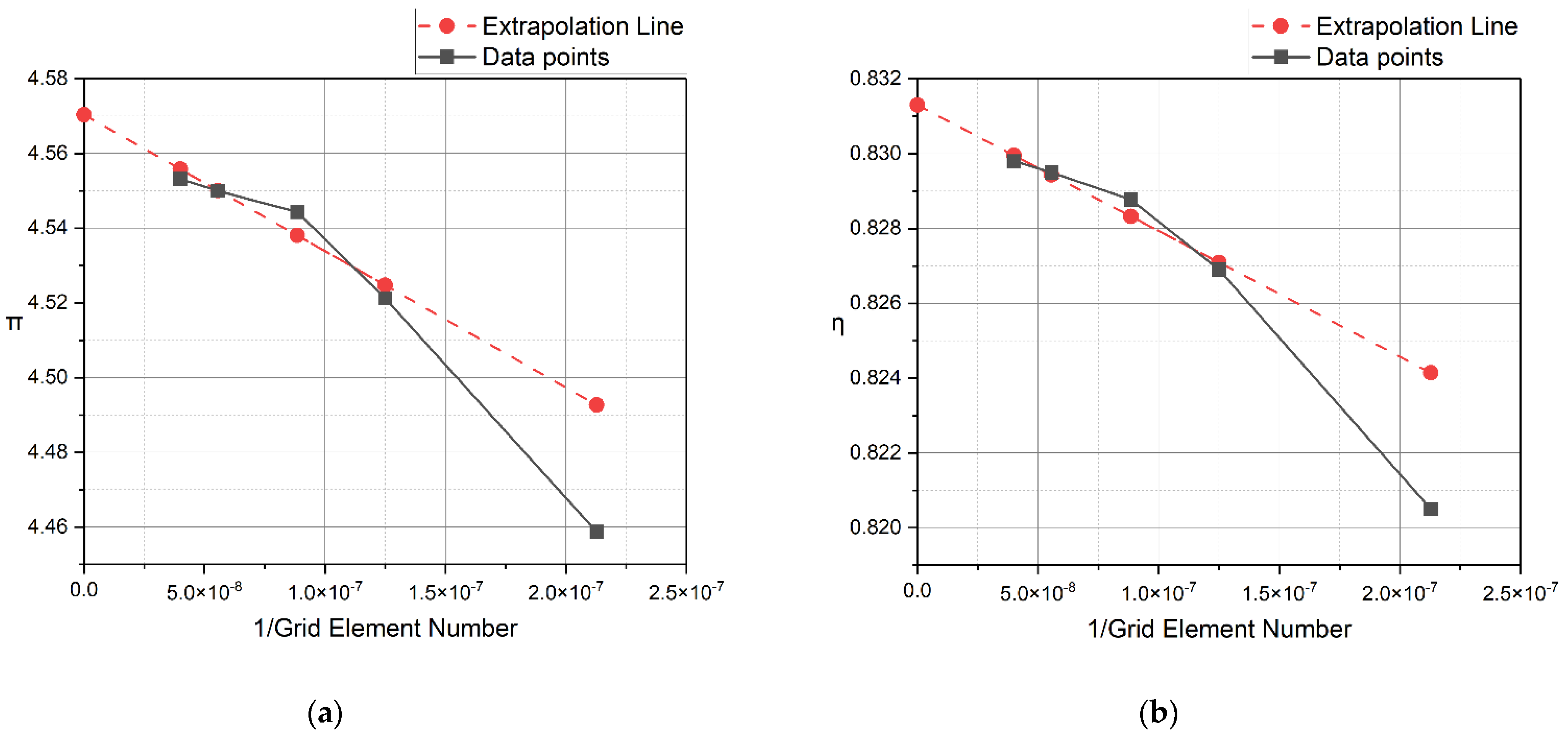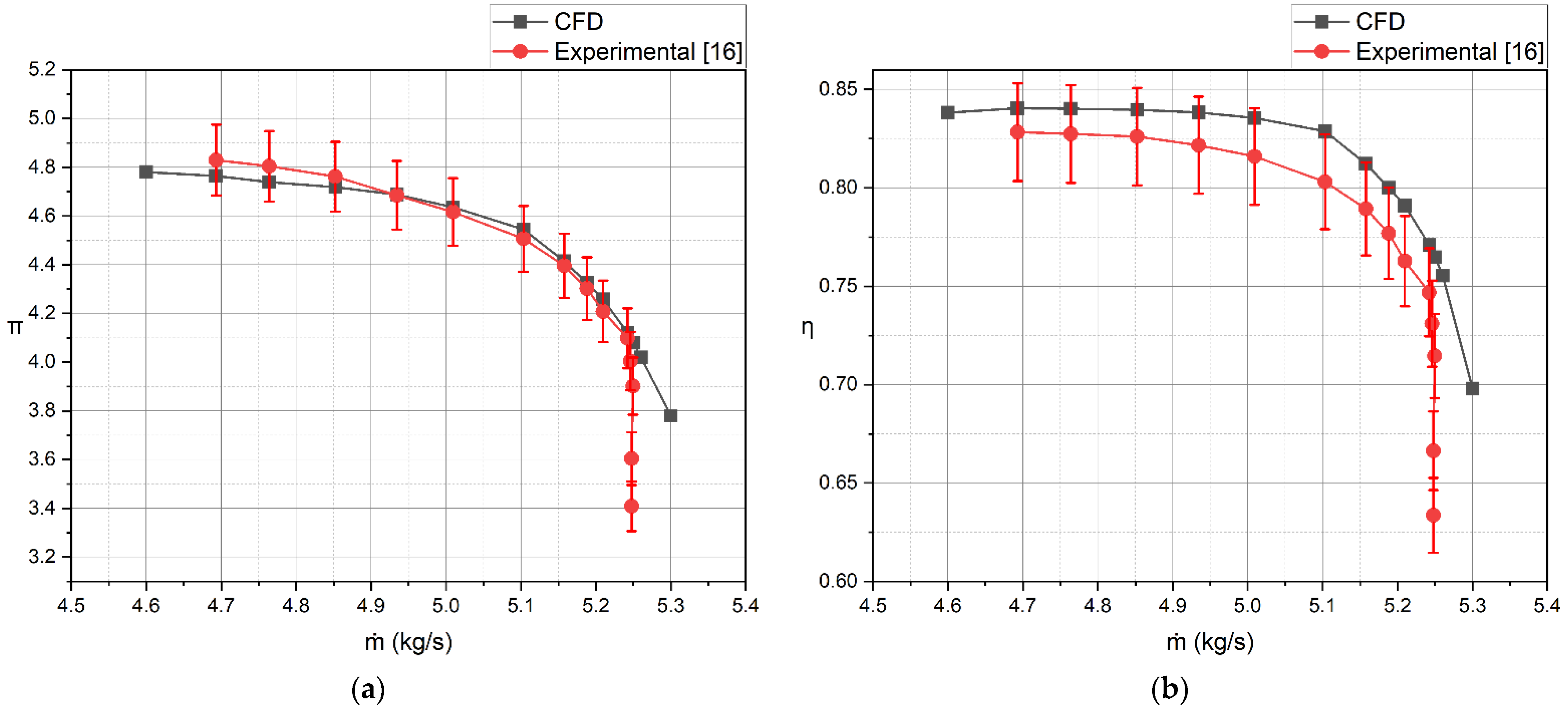Investigation of Suction Flow Control on Centrifugal Compressor with Vaned Diffuser
Abstract
:1. Introduction
2. Problem Definition
Compressor Geometry
3. Methodology
3.1. CFD Model
3.2. Boundary and Operating Conditions
3.3. Grid Independence Tests
4. Results
4.1. Compressor Operating Line: Uncontrolled Case
4.2. Suction Control Studies: Controlled Cases
4.2.1. Flow Control Studies at Operation Flow Rate (O.F.R.)
4.2.2. Flow Control Studies at Stall Flow Rate (S.F.R.)
5. Discussion
6. Conclusions
Author Contributions
Funding
Institutional Review Board Statement
Informed Consent Statement
Data Availability Statement
Acknowledgments
Conflicts of Interest
References
- Lawless, P.B.; Fleeter, S. Active Control of Rotating Stall in a Low-Speed Centrifugal Compressor. J. Propuls. Power 1999, 15, 38–44. [Google Scholar] [CrossRef]
- Nelson, E.B.; Paduano, J.D.; Epstein, A.H. Active Stabilization of Surge in an Axi-Centrifugal Turboshaft Engine. ASME J. Turbomach. 2000, 122, 485–493. [Google Scholar] [CrossRef]
- Stein, A.; Niazi, S.; Sankar, L. Numerical analysis of stall and surge in a high-speed centrifugal compressor. In Proceedings of the AIAA 2000-226, 38th Aerospace Sciences Meeting and Exhibit, Reno, NV, USA, 10–13 January 2000. [Google Scholar] [CrossRef]
- Spakovszky, Z.S. Backward Traveling Rotating Stall Waves in Centrifugal Compressors; ASME Turbo Expo: Amsterdam, The Netherlands, 2002. [Google Scholar]
- Skoch, G.J. Experimental investigation of centrifugal compressor stabilization techniques. J. Turbomach. 2003, 125, 704–713. [Google Scholar] [CrossRef] [Green Version]
- Skoch, G.J. Experimental investigation of diffuser hub injection to improve centrifugal compressor stability. J. Turbomach. 2005, 127, 107–117. [Google Scholar] [CrossRef]
- Nie, C.; Tong, Z.; Geng, S.; Zhu, J.; Huang, W. Experimental investigations of micro air injection to control rotating stall. J. Therm. Sci. 2007, 16, 1–6. [Google Scholar] [CrossRef]
- Hirano, T.; Uchide, T.; Tsujita, H. Control of surge in centrifugal compressor by using a nozzle ınjection system: Universality in optimal position of injection nozzle. Int. J. Rotating Mach. 2012, 2012, 259293. [Google Scholar] [CrossRef]
- Hirano, T.; Takano, M.; Tsujita, H. Effect of double air injection on performance characteristics of centrifugal compressor. J. Therm. Sci. 2015, 24, 10–16. [Google Scholar] [CrossRef]
- Taghavi-Zenouz, R.; Solki, E.; Afshari, H. Performance Enhancement of Centrifugal Compressors Utilizing Impeller Tip Injection. J. Mech. 2016, 32, 453–461. [Google Scholar] [CrossRef]
- Halawa, T.; Gadala, M.S.; AlQaradawi, M.; Badr, O. Optimization of the Efficiency of Stall Control Using Air Injection for Centrifugal Compressors. J. Eng. Gas Turbines Power 2015, 137, 072604. [Google Scholar] [CrossRef]
- Gao, C.; Huang, W.; Zheng, T.; Yang, K.; Yang, H.; Cao, Y. Experimental and Numerical Investigations of Surge Extension on a Centrifugal Compressor with Vaned Diffuser Using Steam Injection. Int. J. Rotating Mach. 2017, 2017, 9159516. [Google Scholar] [CrossRef]
- Marsan, A.; Trébinjac, I.; Moreau, S.; Coste, S. Active Flow Control in a Radial Vaned Diffuser for Surge Margin Improvement: A Multislot Suction Strategy. Int. J. Rotating Mach. 2017, 2017, 4120862. [Google Scholar] [CrossRef]
- Mirzaee, S.; Zheng, X.; Lin, Y. Improvement in the stability of a turbocharger centrifugal compressor by tip leakage control. Proc. Inst. Mech. Eng. Part D J. Automob. Eng. 2016, 231, 700–714. [Google Scholar] [CrossRef]
- Yin, H.; Wu, H.; Li, Y.; Quan, J. Performance analysis of the water-injected centrifugal vapor compressor. Energy 2020, 200, 117538. [Google Scholar] [CrossRef]
- Medic, G.; Sharma, O.P.; Jongwook, J.; Hardin, L.W.; McCormick, D.C.; Cousins, W.T.; Lurie, E.A.; Shabbir, A.; Holley, B.M.; Slooten, R.V. High Efficiency Centrifugal Compressor for Rotorcraft Applications; NASA Contractor Report; United Technologies Research Center: East Hartford, CT, USA, 2014. [Google Scholar]
- Ansys Inc. Ansys CFX-Solver Theory Guide 2020 R1; Ansys Inc.: Canonsburg, PA, USA, 2020. [Google Scholar]
- Menter, F.R. Two-equation eddy-viscosity turbulence models for engineering applications. AIAA J. 1994, 32, 1598–1605. [Google Scholar] [CrossRef] [Green Version]
- Bourgeois, J.A.; Martinuzzi, R.J.; Savory, E.; Zhang, C.; Roberts, D.A. Assessment of Turbulence Model Predictions for an Aero-Engine Centrifugal Compressor. J. Turbomach. 2010, 133, 011025. [Google Scholar] [CrossRef]
- Mangani, L.; Casartelli, E.; Mauri, S. Assessment of Various Turbulence Models in a High Pressure Ratio Centrifugal Compressor with an Object Oriented CFD Code. J. Turbomach. 2012, 134, 061033. [Google Scholar] [CrossRef]
- Carretta, M.; Cravero, C.; Marsano, D. Numerical Prediction of Centrifugal Compressor Stability Limit. In Proceedings of the ASME Turbo Expo 2017: Turbomachinery Technical Conference and Exposition GT2017, Charlotte, NC, USA, 26–30 June 2017. [Google Scholar] [CrossRef]
- Gibson, L.; Galloway, L.; Kim, S.I.; Spence, S. Assessment of turbulence model predictions for a centrifugal compressor simulation. J. Glob. Power Propuls. Soc. 2017, 1, 2II890. [Google Scholar] [CrossRef]
- Zamiri, A.; Lee, B.J.; Chung, J.T. Numerical evaluation of transient flow characteristics in a transonic centrifugal compressor with vaned diffuser. Aerosp. Sci. Technol. 2017, 70, 244–256. [Google Scholar] [CrossRef]
- Ghenaiet, A.; Khalfallah, S. Assessment of some stall-onset criteria for centrifugal compressors. Aerosp. Sci. Technol. 2019, 88, 193–207. [Google Scholar] [CrossRef]
- Leichtfuß, S.; Bühler, J.; Schiffer, H.-P.; Peters, P.; Hanna, M. A Casing Treatment with Axial Grooves for Centrifugal Compressors. Int. J. Turbomach. Propuls. Power 2019, 4, 27. [Google Scholar] [CrossRef] [Green Version]
- Galerkin, Y.; Rekstin, A.; Marenina, L.; Drozdov, A.; Solovyeva, O.; Semenovskiy, V. Optimization of Return Channels of High Flow Rate Centrifugal Compressor Stages Using CFD Methods. Energies 2020, 13, 5968. [Google Scholar] [CrossRef]
- Cumpsty, N.A. Compressor Aerodynamics, 1st ed.; Addison Wesley Longman Limited: Cardiff, UK, 1998; p. 367. [Google Scholar]











| Number of Elements [Million] | Pressure Ratio (π) | Error Rate of π by Experiment [%] | Error Rate of π by Extrapolation [%] | Adiabatic Efficiency (η) | Error Rate of η by Experiment [%] | Error Rate of η by Extrapolation [%] | |
|---|---|---|---|---|---|---|---|
| Experiment [16] | - | 4.506 | - | - | 0.803 | - | - |
| Mesh 1 | 4.7 | 4.458 | 1.06 | 2.44 | 0.821 | 2.17 | 1.30 |
| Mesh 2 | 8 | 4.521 | 0.33 | 1.08 | 0.827 | 2.96 | 0.53 |
| Mesh 3 | 11.3 | 4.544 | 0.84 | 0.57 | 0.829 | 3.2 | 0.30 |
| Mesh 4 | 18 | 4.55 | 0.97 | 0.45 | 0.830 | 3.29 | 0.22 |
| Mesh 5 | 25 | 4.553 | 1.03 | 0.38 | 0.830 | 3.33 | 0.18 |
| Operating Mass Flow | Surge Mass Flow | |
|---|---|---|
| Blade Side | Pressure Side | Suction Side |
| Span Location [%] | 25, 50 | 25, 50, 75 |
| Chord Location [%] | 2, 5, 10, 15 | 50 |
| Control Type | Total Mass Flow Suction Rate [%] | Pressure Ratio (π) | Adiabatic Efficiency (η) | P.R. Change [%] | A.E. Change [%] |
|---|---|---|---|---|---|
| Uncontrolled | − | 4.5449 | 0.8288 | − | − |
| O.F.R. Flow Control 1 | 0.351 | 4.5862 | 0.8356 | 0.91 | 0.81 |
| O.F.R. Flow Control 2 | 0.253 | 4.5828 | 0.8336 | 0.83 | 0.57 |
Publisher’s Note: MDPI stays neutral with regard to jurisdictional claims in published maps and institutional affiliations. |
© 2022 by the authors. Licensee MDPI, Basel, Switzerland. This article is an open access article distributed under the terms and conditions of the Creative Commons Attribution (CC BY) license (https://creativecommons.org/licenses/by/4.0/).
Share and Cite
Ak, S.E.; Cadirci, S. Investigation of Suction Flow Control on Centrifugal Compressor with Vaned Diffuser. Energies 2022, 15, 583. https://doi.org/10.3390/en15020583
Ak SE, Cadirci S. Investigation of Suction Flow Control on Centrifugal Compressor with Vaned Diffuser. Energies. 2022; 15(2):583. https://doi.org/10.3390/en15020583
Chicago/Turabian StyleAk, Suleyman Emre, and Sertac Cadirci. 2022. "Investigation of Suction Flow Control on Centrifugal Compressor with Vaned Diffuser" Energies 15, no. 2: 583. https://doi.org/10.3390/en15020583






